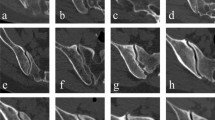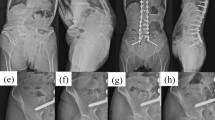Abstract
Purpose
Recently, the number of adult spinal deformity surgeries including sacroiliac joint fixation (SIJF) by using an S2 alar iliac screw or iliac screw has increased to avoid the distal junctional failure. However, we occasionally experienced patients who suffered from hip pain after a long instrumented spinal fusion. We hypothesized that long spinal fusion surgery including SIJF influenced the hip joint as an adjacent joint. The aim of this paper was to evaluate the association between spinal deformity surgery including SIJF and radiographic progression of hip osteoarthritis (OA).
Methods
This study was retrospective cohort study. In total, 118 patients who underwent spinal fusion surgery at single center from January 2013 to August 2018 were included. We measured joint space width (JSW) at central space of the hip joint. We defined reduction of more than 0.5 mm/year in JSW as hip OA progression. The patients were divided into two groups depending on either a progression of hip osteoarthritis (Group P), or no progression (Group N).
Results
The number of patients in Group P and Group N was 47 and 71, respectively. Factor that was statistically significant for hip OA was SIJF (p = 0.0065, odds ratio = 7.1, 95% confidence interval = 1.6–31.6). There were no other significant differences by the multiple logistic regression analysis.
Conclusion
This study identified spinal fixation surgery that includes SIJF as a predictor for radiographic progression of hip OA over 12 months. We should pay attention to hip joint lesions after adult spinal deformity surgery, including SIJF.


Similar content being viewed by others
Availability of data and materials
The datasets during and/or analyzed during the current study are available from the corresponding author on reasonable request.
Code availability
The datasets during and/or analyzed during the current study are available from the corresponding author on reasonable request.
References
Swank S, Lonstein JE, Moe JH et al (1981) Surgical treatment of adult scoliosis: a review of two hundred and twenty-two cases. J Bone Joint Surg Am 63(2):268–287
Yagi M, King AB, Boachie-Adjei O (2012) Incidence, risk factors, and natural course of proximal junctional kyphosis: surgical outcomes review of adult idiopathic scoliosis. Spine 37:1479–1489
Si G, Li T, Liu X et al (2020) Correlation analysis between postoperative hip pain and spino-pelvic/hip parameters in adult scoliosis patients after long-segment spinal fusion. Eur Spine J 29:2990–2997
Hashimoto K, Aizawa T, Kanno H et al (2019) Adjacent segment degeneration after fusion spinal surgery- a systematic review. Int Orthop 43:987–993
Kim KT, Lee SH, Lee YH et al (2006) Clinical outcomes of 3 fusion methods through the posterior approach in the lumbar spine. Spine 31:1351–1357
Onsel C, Collier BD, Kir KM et al (1992) Increased sacroiliac joint uptake after lumbar fusion and/or laminectomy. Clin Nucl Med 17:283–287
Rahm MD, Hall BB (1996) Adjacent-segment disease degeneration after lumbar fusion with instrumentation: a retrospective study. J Spinal Disord 9:392–400
Tateuchi H, Koyama Y, Akiyama H et al (2017) Daily cumulative hip moment is associated with radiographic progression of secondary hip osteoarthritis. Osteoarthr Cartil 25:1291–1298
Ivanov AA, Kiapur A, Ebraheim NA et al (2009) Lumbar fusion leads to increase in angular motion and stress across sacroiliac joint: a finite element study. Spine 34(5):E162–E169
Sembrano JN, Reiley MA, Polly DW et al (2011) Diagnosis and treatment of sacroiliac joint pain. Curr Orthop Pract 22(4):344–350
Vleeming A, Schuenke MD, Masi AT et al (2012) The sacroiliac joint: an overview of its anatomy, function and potential clinical implications. J Anat 221(6):537–567
Denis F, Sun EC, Winter RB (2009) Incidence and risk factors for proximal and distal junctional kyphosis following surgical treatment for Scheurmann kyphosis: minimum five-year follow-up. Spine 34:E729-734
Untch C, Liu Q, Hart R et al (2004) Segmental motion adjacent to an instrumented lumbar fusion: the effect of extension of fusion to the sacrum. Spine 29:2376–2381
Kinon MD, Nasser R, Nakhla JP et al (2016) Predictive parameters for the antecedent development of hip pathology associated with long segment fusions to the pelvis for the treatment of adult spinal deformity. Surg Neurol Int 7:93
Shum GLK, Crosbie J, Lee RYW (2005) Effect of low back pain on the kinematics and joint coordination of the lumbar spine and hip during sit-to-stand and stand-to-sit. Spine 30:1998–2004
Tateuchi H, Akiyama H, Goto K et al (2018) Sagittal alignment and mobility of the thoracolumbar spine are associated with radiographic progression of secondary hip osteoarthritis. Osteoarthr Cartil 26:397–404
Esposito CI, Miller TT, Kim HJ et al (2016) Does degenerative lumbar spine disease influence femoroacetabular flexion in patients undergoing total hip arthroplasty? Clin Orthop Relat Res 474:1788–1797
Jorge JP, Simoes FM, Pires EB et al (2014) Finite element simulations of a hip joint with femoroacetabular impingement. Comput Methods Biomech Biomed Eng 17(11):1275–1284
Tateuchi H, Koyama Y, Akiyama H et al (2016) Radiographic and clinical factors associated with one-leg standing and gait in patients with mild-to-moderate secondary hip osteoarthritis. Gait Posture 49:207–212
Chevalier X, Conrozier T, Gehrmann M et al (2001) Tissue inhibitor of metalloprotease-1 (TIMP-1) serum level may predict progression of hip osteoarthritis. Osteoarthr Cartil 9:300–307
Chen GX, YangLi LK et al (2013) A three-dimensional finite element model for biomechanical analysis of the hip. Cell Biochem 67:803–808
Lequesne M (1995) Chondrometry quantitative evaluation of joint space width and rate of joint space loss in osteoarthritis of the hip. Rev Rheum Engl Ed 62:155–158
Wright AA, Cook C, Abbott JH (2009) Variables associated with the progression of hip osteoarthritis: a systematic review. Arthritis Rheum 61(7):925–936
Funding
None.
Author information
Authors and Affiliations
Contributions
TK and HH designed and performed the experiments, derived the models and analyzed the data. IH, ST, and MT performed surgical procedure. YY, AM, HO and HY encouraged TK to investigate and supervised the findings of this work. KN, RT, and SM assisted with measurements. TK wrote the manuscript in consultation with all authors.
Corresponding author
Ethics declarations
Conflict of interest
None of the authors have any conflict of interest to declare.
Ethics approval
All patients provided informed consent prior to surgery, and the study protocol was approved by the institutional ethical committee of Wakayama Medical University.
Consent to participate
All patients provided informed consent prior to surgery.
Consent for publication
All patients provided informed consent for publication.
Additional information
Publisher's Note
Springer Nature remains neutral with regard to jurisdictional claims in published maps and institutional affiliations.
Rights and permissions
About this article
Cite this article
Kozaki, T., Hashizume, H., Nishiyama, D. et al. Adjacent segment disease on hip joint as a complication of spinal fusion surgery including sacroiliac joint fixation. Eur Spine J 30, 1314–1319 (2021). https://doi.org/10.1007/s00586-020-06700-4
Received:
Revised:
Accepted:
Published:
Issue Date:
DOI: https://doi.org/10.1007/s00586-020-06700-4




